When Matt Irving joined WP Engine, the WordPress experience platform, as its Manager of Global Partner Operations, he knew he needed a way to explain how partnerships impact the business beyond revenue.
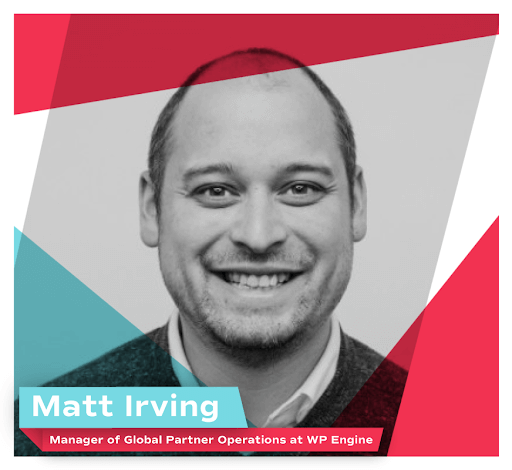 “Partner operations teams are measured on throughput vs. sales teams are measured on output. For partner operations, the question we’re trying to answer is ‘Are we getting better or worse?’” says Irving.
“Partner operations teams are measured on throughput vs. sales teams are measured on output. For partner operations, the question we’re trying to answer is ‘Are we getting better or worse?’” says Irving.
It’s tough to answer that question with the traditional sales and marketing funnel because it focuses on achieving an outcome — like winning a deal or formally signing a new partner — but it fails to show what influenced that outcome and what happens after it’s achieved. To use a sales or marketing funnel alone would only tell half the story about your partner’s journey.
That’s why WP Engine’s partnerships team uses the “bow-tie” funnel, a horizontal funnel with three main parts just like its namesake: A left side (prospects to partners), a knot (signed partners), and a right side (partners to advocates). It’s a process for describing and measuring the end-to-end partner journey, from the moment a company is a prospective partner all the way to them becoming a full-on advocate — a champion for the partner program that’s generating repeat business. Unlike the vertical sales funnel, the bow-tie funnel shows you what happens after a partner commits to your program.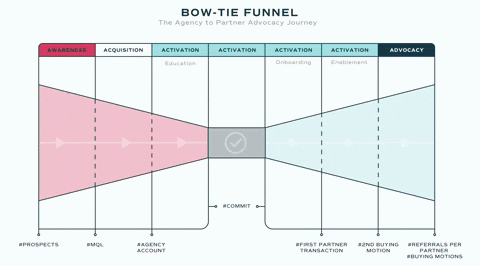
Irving uses the bow-tie funnel to understand:
- How quickly are companies traveling through WP Engine’s partner journey, and where are they getting stuck?
- How many partners are becoming advocates?
Regular analysis of the bow-tie funnel has helped WP Engine’s partnerships team reduce its agency partners’ time to first referral from months to days. Since its agency program launched in 2017, WP Engine increased its signed partners by 50% year-over-year. They have more than 5,000 agency partners.
In this post, you’ll learn:
- How the Bow-Tie Funnel Works
- The 7 Stages of the Bow-Tie Funnel
- Stage 1: Awareness
- Stage 2: Acquisition
- Stage 3: Education
- Stage 4: Commit (The “Knot”)
- Stage 5: Onboarding
- Stage 6: Enablement
- Stage 7: Advocacy
- Use Cases for the Bow-Tie Funnel
How the Bow-Tie Funnel Works
 Source: Matt Irving, Manager of Global Partner Operations at WP Engine
Source: Matt Irving, Manager of Global Partner Operations at WP Engine
The bow-tie funnel is bigger and a tad more complex than the vertical sales funnel, so let’s break it down piece by piece. First, notice the four headings at the top of the funnel: Awareness, Acquisition, Activation, and Advocacy. These four “A’s” are the main phases of a partner’s journey.
(Note: The “Activation” phase is like an umbrella for three separate stages: education, commit, onboarding, and enablement. That’s why the bow-tie funnel has seven total stages, but we’ll dig into those later on.)
The goal is to shepherd partners from the left to the right by:
- Building companies’ awareness about your partner program
- Acquiring those companies as leads for your partner program
- Activating those partners through education so they decide to formally join your partner program, and then providing them additional onboarding and enablement support
- Helping partners hit program goals and drive repeatable revenue so they become partner advocates
While WP Engine’s team uses the bow-tie funnel primarily for its agency and affiliate partners, the process can be applied to any type of partnership. “Some companies may go through these stages faster than others, and some of the stages may differ depending on what types of third parties you work with,” says Irving.
For example, the onboarding phase is likely faster for an affiliate partner vs. a reseller partner that has to complete multiple product and sales training sessions. For a tech partnership, the knot in the funnel would be a launched integration but for an agency partnership, it would be a signed partner agreement.
The beauty of the bow-tie funnel is it creates a shared language across your organization for how you work with third-parties (For more funnel use cases, skip ahead). Irving got inspiration for the bow-tie funnel from Winning By Design’s video, Data Model: Understanding the Data You Measure in Revenue Organizations.
The 7 Stages of the Bow-Tie Funnel
WP Engine’s bow-tie funnel has seven stages: awareness, acquisition, education, commit, onboarding, enablement, and advocacy. The WP Engine team uses Salesforce to map data to each of these stages.
Let’s unpack each stage together.
Stage 1: Awareness

WP Engine’s prospective partners — those companies who use WordPress or offer WordPress services — live in the “Awareness” stage. This pool of prospects are in lead lists or spreadsheets containing companies who might be a fit for WP Engine’s agency partner program. The goal is to convert a prospect to a marketing qualified lead (MQL) — an agency that has an account record in Salesforce.
To do this, the WP Engine team runs marketing awareness campaigns — including events, paid advertising, account-based marketing, and content — to target prospects and help them answer the question, “Why WordPress?”
For example, the WP Engine team might get a booth at an AWS tradeshow to network with developers who are interested in learning WordPress development best practices. Or, they might host a webinar to educate prospects about WordPress’ capabilities and how other companies are building services around WordPress.
None of this promotes WP Engine’s partner program directly, but it begins to attract the kind of agency who could possibly be a future partner. Those agencies that are interested offer their contact information in exchange for educational content about WordPress’ capabilities. That’s how they end up as an MQL in Salesforce.
Stage 2: Acquisition

A prospect hits the acquisition stage as soon as it becomes an MQL. The goal is to convert the MQL to an agency account, a company that has signed up for a WP Engine developer account.
To drive this conversion, the WP Engine team will use outbound tactics, like emailing and cold calling, and inbound content marketing to introduce WP Engine’s capabilities and the benefits of its developer program.
Signing up for a developer account shows more intent and interest from the company, and it gives them a chance to tinker around with WP Engine’s platform for free. Plus, it allows the agency to unlock a partnership perk before formally joining the agency program.
“You’re trying to basically help a third-party with pattern recognition. The partner is likely thinking, “I have some client in my head and I want to see if I could use you for it,” says Irving.
Developers can see for themselves how WP Engine’s platform can improve their workflows and development lifecycle, and how it can support more WordPress use cases for clients.
Stage 3: Education

At this stage, the WP Engine team works to convert the agency from using a developer account to them formally joining WP Engine’s partner program.
WP Engine’s business development team will go into account management mode, building relationships with key stakeholders and regularly communicating with them. This is also where Tony Gilharry, Senior Manager of Partnerships, enters the picture: He’ll offer education materials and training sessions to show agencies how WP Engine solves certain use cases and how the company works with other partners.
The agencies that are highly engaged will even request training sessions to learn how WP Engine maps with their software development lifecycle. Some agencies will take it a step further and want to work on a joint project or proof of concept before formally signing a partnership agreement.
Stage 4: Commit (The “Knot”)
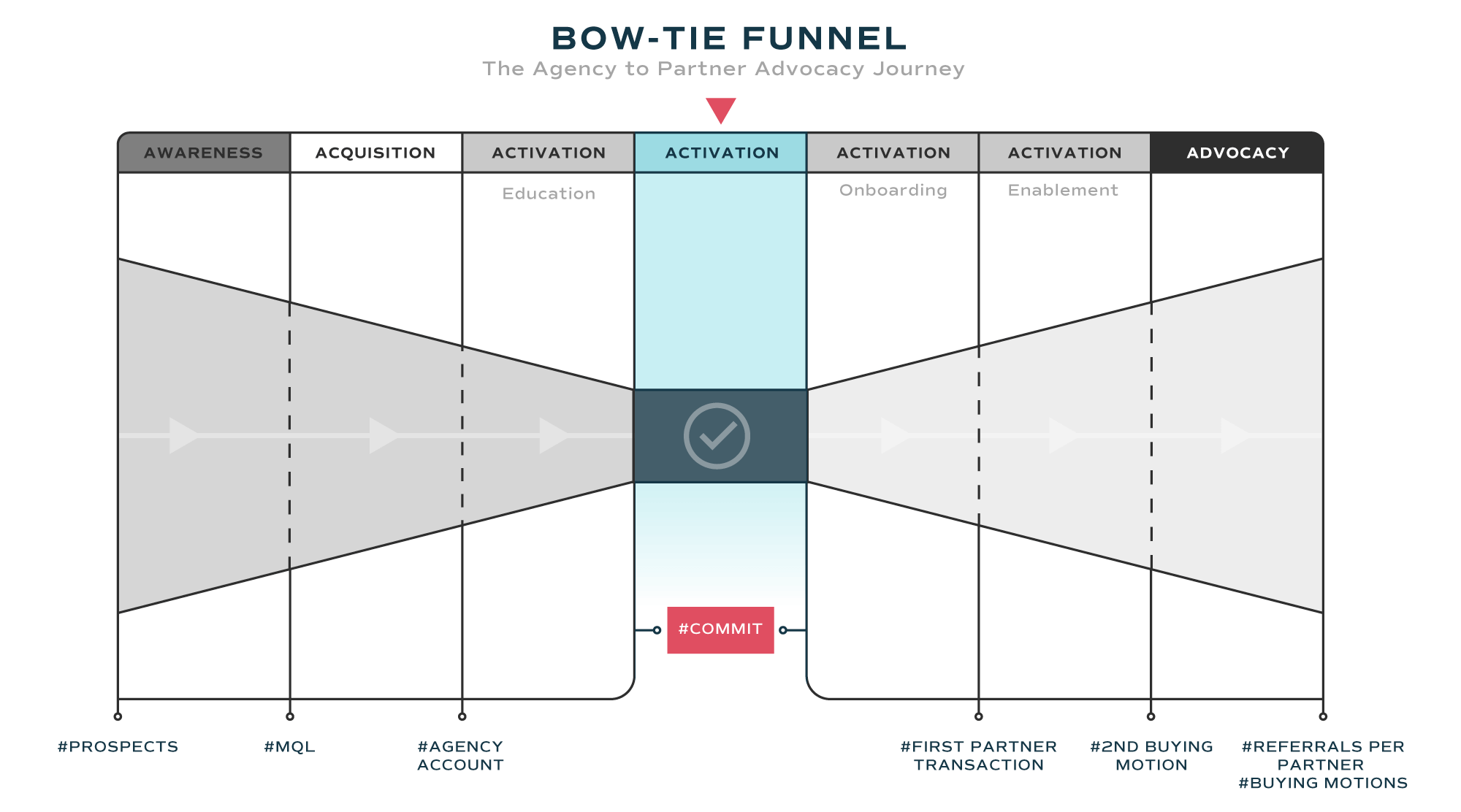
Once the agency has finalized its decision, it signs a formal partnership agreement which gives it access to a dedicated partner account manager, the partner portal, enablement, sales support, a partner directory listing, access to WP Engine’s platform and developer tools, co-branded landing pages, and more.
This is the center of the bow tie and when the prospect becomes a partner.
In this stage, the WP Engine team measures metrics like win rate (the percentage of agency prospects becoming formal partners) and the number of days it takes for an agency to go from prospect to partner.
Stage 5: Onboarding
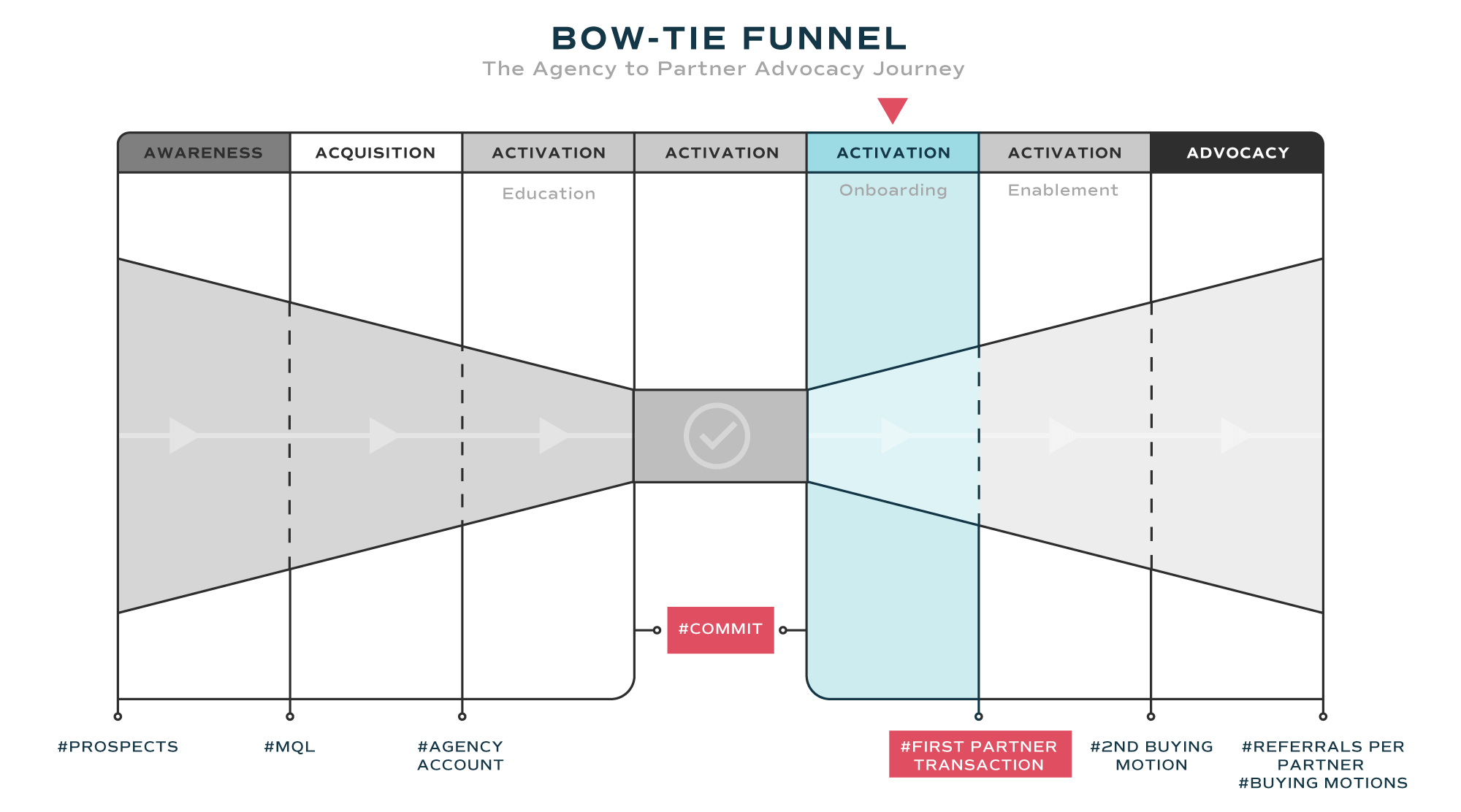
The onboarding stage is about giving partners the tools, training, and education they need to start being productive. The end goal of the 90-day onboarding period is for an agency partner to get its first partner transaction (or first referral), which can be a customer referral or an actual deal with a pipeline number attached to it.
During this time, WP Engine’s assigned partner account manager (PAM) works closely with the partner’s team to further develop the agency relationship and provide hands-on training sessions and education materials.
Partners use WP Engine’s partner portal to also access self-service education and training, connect with other agencies, learn about WP Engine’s customers, interact with the partner support team, and much more. Think of the partner portal as a hub that connects WP Engine to its partners.
The onboarding process is designed to help the partner understand WP Engine’s platform and capabilities. It’s meant to give them just enough information to where they can go out into the wild and convey value to a customer within 90 days.
And what happens if a partner hits that first referral within the 90-day period of their onboarding? At that point, the partnership gets accelerated. “We actually double-down and provide more resources to those partners who come pretty much with deals in hand,” says Gilharry.
Stage 6: Enablement

In this stage, the WP Engine team provides deeper enablement to partners — more advanced trainings that teach agencies how to develop services that complement WP Engine’s platform and solve additional customer use cases. The goal is to help the agency achieve its second buying motion.
Irving says, “From the enablement perspective, we can train people to look for these types of customers. Can we train them now to service different types of customers? We help train them on when those customers are successful and when they’re not. And if they’re not successful, what are services that you can offer to your customer to make them successful?”
Some of the training sessions might turn into collaborative workshops where the agency partner and the WP Engine team put their heads together to solve a unique use case for a specific client.
Stage 7: Advocacy
This stage is about helping the partner diversify its overall book of business in terms of referrals, deals that they’re working on, and to help deepen the nature of their partnership (think: more co-selling and customized partner enablement training and support).
The goal is to help partners get on a regular referral cadence by working alongside them to solve more advanced customer use cases. At this stage, Irving and the WP Engine team are measuring the number of referrals per partner and the number of buying motions.
“If we can do one referral a week, then that is pretty much rockstar status. We’re looking for essentially four to five [referrals] per partner per month,” says Gilharry.
WP Engine’s partner team tracks metrics like average customer value over time and average deal size. Irving says, “What kind of variances exist in the price points that they’re bringing? Is it trending upward or downward? For example, you could have a high volume of smaller deals coming from one agency or a few massive ones coming from them.”
This type of analysis shows the WP Engine team if there are better ways for them to support their agency partners. “If they’re getting more sophisticated, how can we come alongside them with the right technical enablement support so that as they’re working in a frontier technology, we’re alongside to help make sure their client is supported, says Irving.
Use Cases for the Bow-Tie Funnel
How you use the bow-tie funnel depends entirely on what types of partners you work with, the volume of partners in your program, and how you structure your partnership operations, or as we call it at Crossbeam: Ecosystem Ops.
Here are three ways Irving and the WP Engine team use the bow-tie funnel:
1. Spotting Leading Indicators of Success
For Irving, revenue is important, but it’s a lagging indicator. “The deal’s already done and the whole sales process has gone through,” he says. “You don’t really know what happened prior to the revenue.” The bow-tie funnel allows him to pay closer attention to leading indicators of success — the activities, conversations, and events speed up the path to revenue.
For WP Engine, time to first referral is a leading indicator of a partner’s success because it helps them identify the inputs that influenced that outcome. Regular analysis of the bow-tie funnel makes it easier to spot patterns that are either accelerating or hindering partners’ success. “When did the [partner] raise their hand that they want to work with us? How did we help them with that? How can we make that faster? What type of engagement is needed from us?” says Irving. “Nailing that side of it will ultimately lead to more revenue.”
2. Creating a Shared Language with Your Executives
Irving uses the bow-tie funnel to educate WP Engine’s business unit leaders about what’s happening in the partnerships org at their monthly business updates meeting. He’s used the funnel to create a shared language with his leadership team on what a “partner” means to WP Engine. When Irving says an agency is an “advocate,” the executive team knows exactly what he’s talking about and the impact it has on the business.
It’s much easier to gain executive buy-in when there’s a shared understanding of expectations. “It’s allowed us to really advocate for more investment,” says Irving. “Like, ‘Hey, we need more field people to go facilitate these kinds of trainings,’ or, ‘We have X amount of agencies asking us for this type of content or this type of training or this type of support’.”
3. Measuring Performance in the Partnerships Org
WP Engine’s partner marketing department focuses on the left side of the funnel, and their goal is to add more agency prospects and show those prospects the possibilities of working with WP Engine. They’re working to optimize this conversion path: prospect > MQL > agency account record > signed partner.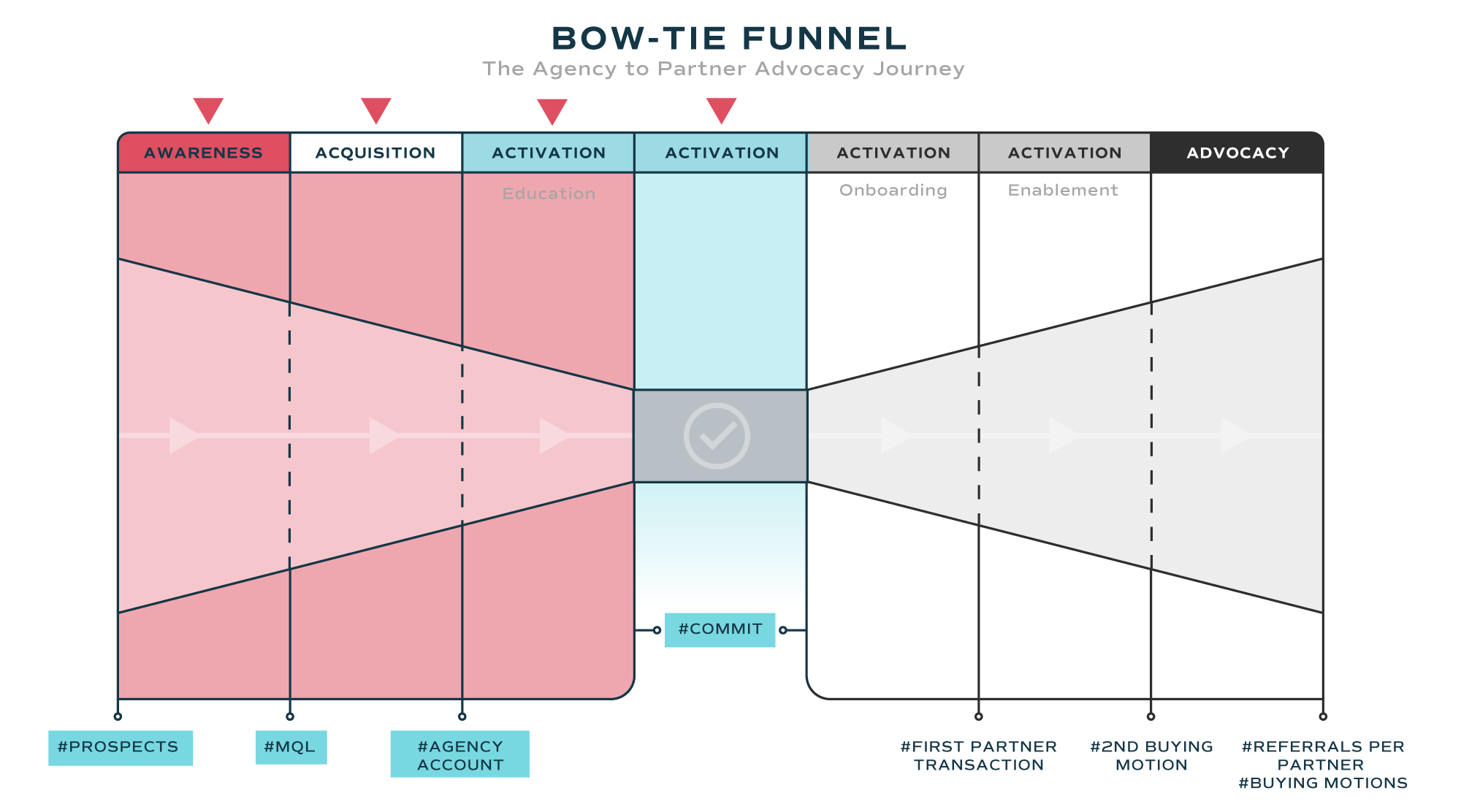
“Number of signed partners” is the core metric for the partner marketing team.
Meanwhile, the right side of the funnel is the partner operation team’s domain. They’re focused on helping those newly signed agency partners ramp up, understand customer use cases, and identify sales opportunities.
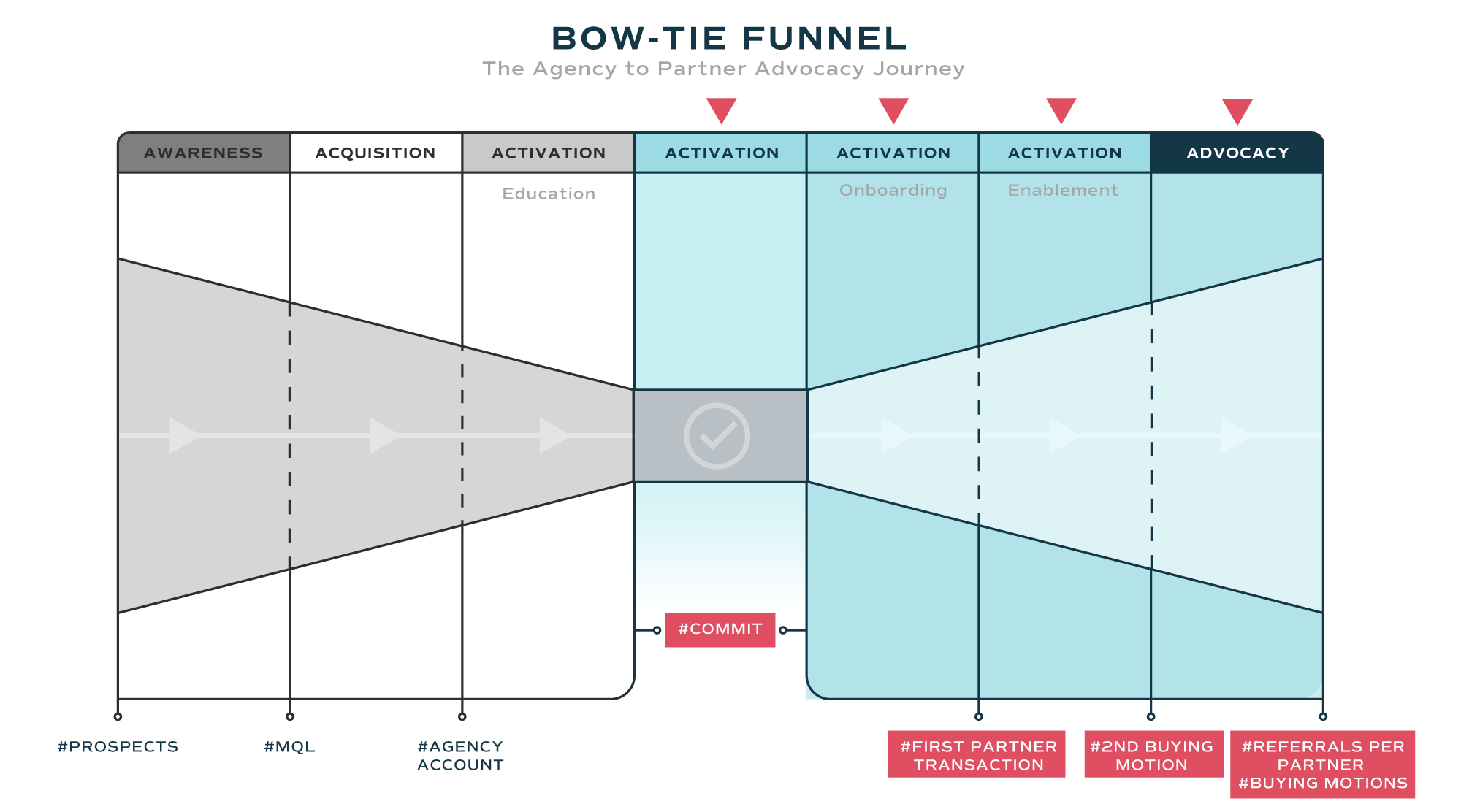
The partner operations team is optimizing this conversion path: time to first referral > second buying motion > referral frequency.
“Time to first referral” is the core metric for the partner operations team. Irving says, “That’s where a kind of self-perpetuating flywheel happens. A partner gets a win and they’re like, where else can I apply this?”


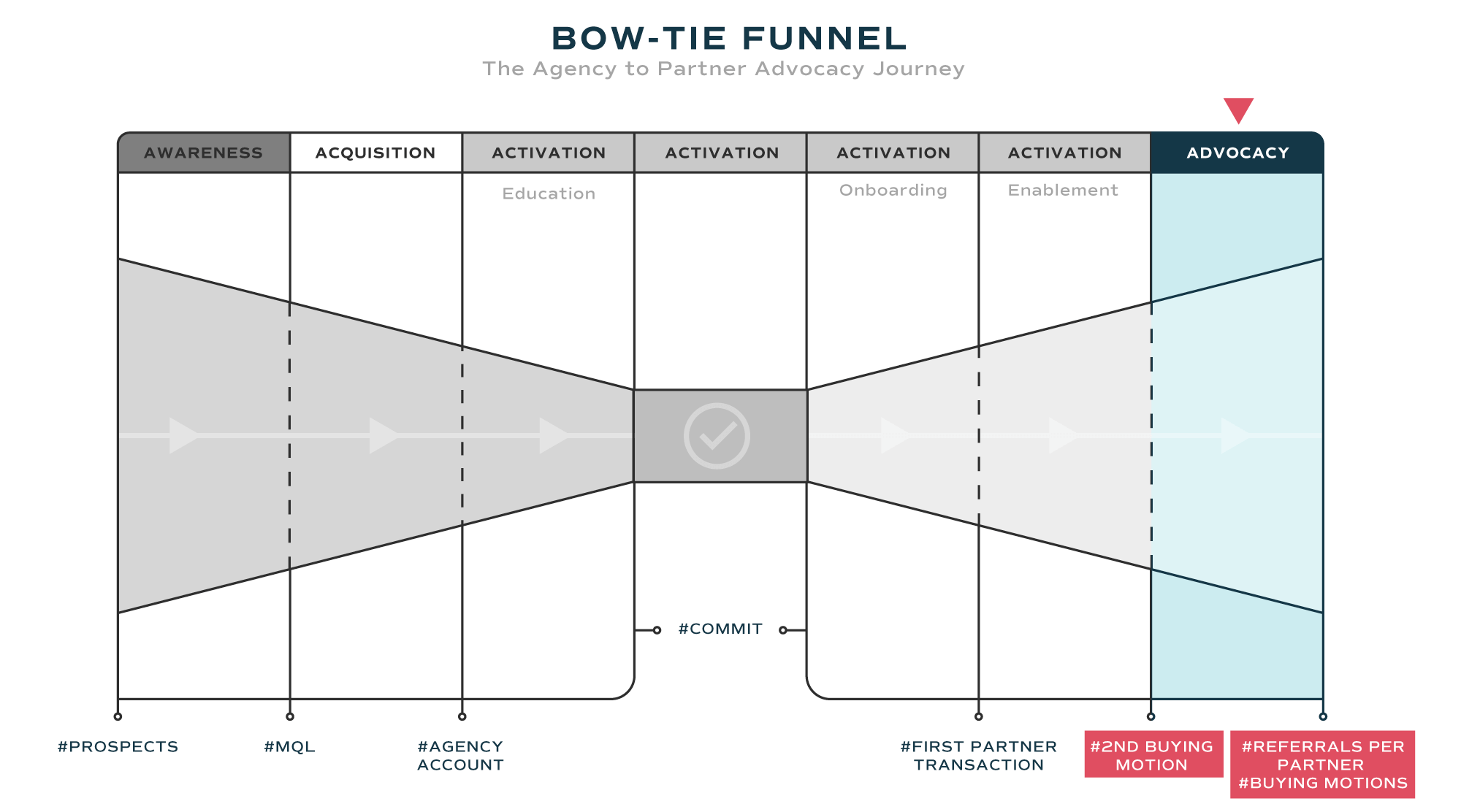


This is a test comment.
This is a longer test comment to see how this looks if the person decides to ramble a bit. So they're rambling and rambling and then they even lorem ipsum.